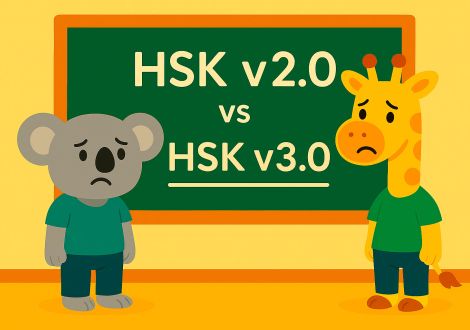HSK Level 1—the most basic level of the official Chinese exam—includes essential vocabulary and simple structures that allow you to introduce yourself, ask basic questions, and navigate everyday situations.
If you’re just starting to study Mandarin Chinese, besides learning vocabulary, it’s important to know how to use it in context. So, here are 20 essential HSK 1 phrases, accompanied by a brief explanation to help you integrate them into your daily study.
1. 你好![nǐ hǎo] → ¡Hello!
The standard form of greeting. Other informal variants include 哈喽 [hālóu] and 嗨 [hāi]. You can also greet someone depending on the time of day: 早上好 [zǎo shang hǎo] means “good morning,” while 下午好 [xiàwǔ hǎo] means “good afternoon.” Another very common option is 你吃了吗?[nǐ chī le ma], which, although it literally means “have you eaten?”, is actually a common way to greet someone.
2. 谢谢 [xièxie] → Thank you
You can also add 你 [nǐ] or 你们 [nǐmen] at the end, meaning “thanks to you” singular/plural (respectively).
3. 不客气 [bú kèqi] → You’re welcome
It’s the usual reply to 谢谢, but you can also use 不用谢 [búyòngxiè] and 没事 [méishì].
4. 对不起 [duìbuqǐ] → I’m sorry
Another way to say this is 不好意思 [búhǎoyīsī].
5. 没关系 [méi guānxi] → It’s okay
A very kind reply. Its translation is ”no problem” or ”it’s fine”.
6. 我叫…… [wǒ jiào…] → My name is…
This is the important structure to introduce oneself in Chinese.
For example: 我叫大卫 [wǒ jiào dà wèi] → My name is David.
7. 你怎么样 [nǐ zěnme yàng] → How are you?
You can use this sentence to ask a friend how he/she is doing.
8. 我很好 [wǒ hěn hǎo] → I’m fine
The standard, most widely used response. Although you can also respond with 还可以 [hái kěyǐ], 不错 [bú cuò], or 还行 [hái xíng], among others. All three could be translated as "fine".
9. ……在哪儿?[......zài nǎ’er] → Where is…?
This structure is really important in order to ask for the location of an object, place or person.
For example: 你的家在哪儿?[nǐ de jiā zài nǎ'er?] → Where is your house?
10. 那/这是什么?[zhè/nà shì shénme] → What is this?
This is used to inquire about something. For example, it’s very useful when we are ordering food and we want to know what something is.
11. 我想…… [wǒ xiǎng…] → I would like…
Again, this is really useful when shopping, or when we are ordering in coffee shops or restaurants, etc. Add 不 before 想 to express what do you not want.
For example: 我想喝咖啡,不想喝茶 [wǒ xiǎng hē kāfēi,bú xiǎng hē chá] → I want to drink coffee, not tea.
12. 我听不懂 [wǒ tīng bù dǒng] → I don’t understand
Your best friend when starting to learn Chinese. You’ll repeat this sentence over and over during your first trip to China.
13. 可以吗?[kěyǐ ma?] → Is it okay?/Can I…?
We use this phrase when we want to ask for permission to do something. We can indicate the action first and then ask if it’s okay or correct to do it.
14. 我会说一点儿中文 [wǒ huì shuō yìdiǎnr Zhōngwén] → I can speak a bit Chinese
Perfect when you are introducing yourself or if someone asks you if you speak Chinese.
15. 请再说一遍 [qǐng zài shuō yí biàn] → Please, can you repeat it?
This phrase goes hand in hand with 我听不懂, as it’s very handy when someone speaks to you too quickly.
16. 太好了![tài hǎo le] → Great!
A positive expression to show enthusiasm.
17. 我是...... [wǒ shì] → I am…
Then, you can add your nationality, your job, if you’re a student, etc.
For example: 我是中国人 [wǒ shì zhōngguó rén] → I am Chinese.
18. 我喜欢…… [wǒ xǐhuan…] → I like…
Ideal for expressing things you like. If you add, 不 before 喜欢, you can also include what you don’t like.
For example: 我喜欢看书,不喜欢看电影 [wǒ xǐhuān kàn shū,bú xǐhuān kàn diànyǐng] → I like reading books, not watching movies.
19. 多少钱?[duōshao qián] → How much is it?
This phrase is vital for surviving in markets and stores. Add 这个/那个 before to refer to a specific object while pointing at it.
20. 再见![zàijiàn] → Bye bye!
The standard farewell in Chinese.





